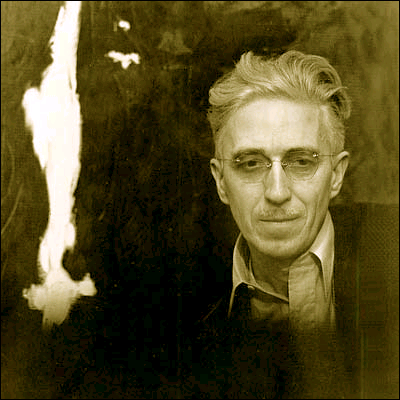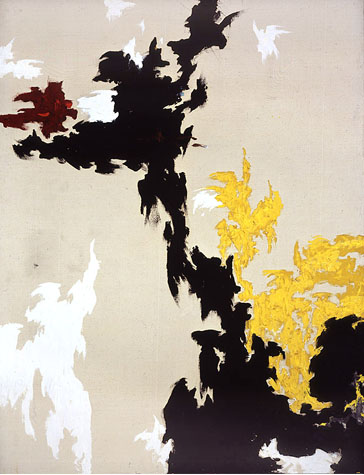CLYFFORD STILL
Master
of Abstract Expressionism

Clyfford Still (November 30, 1904 - June 23, 1980) was an American artist, a painter, and one of the leading figures in Abstract Expressionism. Still was one of the foremost "color field" painters - his paintings are non-objective, and largely concerned with arranging a variety of colors in different formations. However, while Mark Rothko or Hans Hofmann organized their colors in a relatively simple way (Rothko in the form of nebulous rectangles, Newman in thin lines on vast fields of color), Still's arrangements are less regular. His jagged flashes of color give the impression that one layer of color has been "torn" off the painting, revealing the colors underneath. Read more detail in the biography or check out some Clyfford Still quotes about his process.
Clyfford Still, like most of the Abstract Expressionists, loved to listen to music. He had a vast collection of vinyl records, and usually listened to jazz and classical in the studio. In order to save money, the Abstract Expressionists would often paint over old canvasses. Clyfford, however, was very meticulous and would never do that. Still is a huge influence on current well known modern painters such as Cecily Brown, Inka Essenhigh and Shawn McNulty.
Still's early life was marked by the harsh realities of the American Midwest. Growing up in a family of farmers, he experienced the rugged landscapes and tumultuous weather that would later manifest in the raw, elemental quality of his art. His interest in art was sparked during his teenage years, leading him to attend Spokane University and later study at the Art Students League in New York City.
The 1930s saw Still's artistic journey taking shape as he began to develop a unique voice within the context of American modernism. Influenced by the social and political climate of the time, as well as his experiences working with the Federal Art Project during the Great Depression, Still's early works began to exhibit a social consciousness that set him apart from his peers. However, it was during the 1940s, when he became associated with the burgeoning abstract expressionist movement, that Still truly found his artistic home. Abstract expressionism, characterized by its emphasis on spontaneous, gestural expression and the exploration of the subconscious, provided Still with the perfect platform to channel his innermost emotions onto the canvas. His paintings from this period are marked by bold brushstrokes, intense color contrasts, and a dynamic interplay of form and space. One of Still's notable contributions to this movement was his rejection of traditional titles for his paintings, preferring to use numbers or dates to allow viewers to engage directly with the visual experience.

Untitled (PH-118) - 1947, oil on canvas, 69 x 53 inches, © Estate of Clyfford Still
In 1943, Still joined the faculty of the California School of Fine Arts (now the San Francisco Art Institute), where he played a pivotal role in shaping the next generation of artists, including Richard Diebenkorn and David Park. Still's teaching approach reflected his disdain for artistic conventions and his commitment to fostering individualism. His students admired his passion for authenticity and his belief in the transformative power of art. The pinnacle of Clyfford Still's career came in the 1950s when he produced some of his most iconic works. These large-scale canvases, characterized by monumental fields of color and jagged, abstract forms, conveyed a sense of the sublime and the cosmic. His paintings often seemed to transcend the boundaries of the canvas, inviting viewers into a visceral and emotional experience. Still's refusal to conform to artistic norms and his insistence on following his own artistic path led to his decision to break away from the commercial art world.
In 1951, Still severed ties with prominent galleries, including Peggy Guggenheim's Art of This Century, and retreated from the New York art scene. This self-imposed exile allowed him the creative freedom he sought, enabling him to produce some of his most celebrated works. His departure from the art establishment also reflected his disdain for the commodification of art and his desire to protect the integrity of his work from commercial interests. The year 1959 marked a turning point in Still's life when he withdrew his entire body of work from public view, including over 800 paintings and works on paper. This decision, motivated by his frustration with the art world's commercialization and a desire to control the presentation and interpretation of his oeuvre, resulted in the establishment of the Clyfford Still Museum in Denver, Colorado. The museum opened its doors to the public in 2011, providing a comprehensive and unparalleled view of Still's artistic evolution.
Clyfford Still's legacy extends beyond his artistic contributions. His uncompromising stance against compromising his artistic vision, coupled with his withdrawal from the commercial art scene, inspired subsequent generations of artists to reevaluate their relationship with the art market. Still's insistence on maintaining control over the presentation of his work also set a precedent for artists seeking to preserve the integrity of their artistic legacies. Many artists are inspired by insightful quotes by Clyfford Still. Despite his reclusive nature, Still's impact on the art world is immeasurable. He is often included in abstract art definitions as a pioneer of the abstract form. Many wildlife nature artists take influence from his jagged landscapes. His paintings continue to be revered for their emotional intensity, originality, and profound engagement with the human experience. Clyfford Still passed away on June 23, 1980, leaving behind a body of work that stands as a testament to the power of artistic conviction and the enduring impact of one man's uncompromising pursuit of truth through art. Today, on what would have been his 119th birthday, we celebrate Clyfford Still's enduring legacy and the indelible mark he left on the world of contemporary art.
The Clyfford Still Museum, located in Denver, Colorado, stands as a testament to the singular vision and uncompromising spirit of one of the 20th century's foremost abstract expressionist artists. Founded in 2011, the museum houses the complete works of Clyfford Still, comprising over 800 paintings and works on paper, meticulously curated to provide a comprehensive journey through the artist's evolution. The museum's architectural design, with its stark and modern aesthetic, serves as a fitting backdrop to Still's monumental and emotionally charged canvases. By withdrawing his work from public view for decades, Still aimed to preserve the integrity of his artistic legacy, and the Clyfford Still Museum fulfills this vision by offering visitors a unique and immersive experience into the life and mind of an artist who reshaped the landscape of American art.